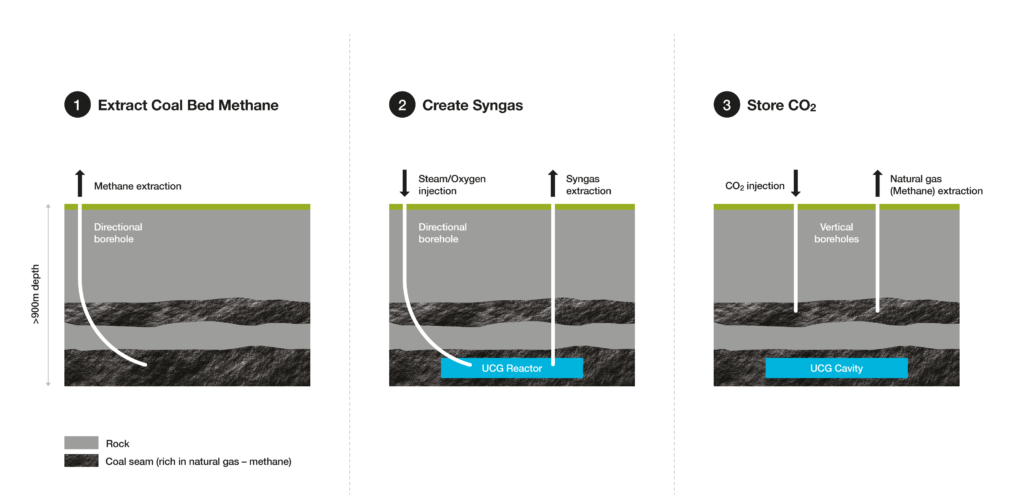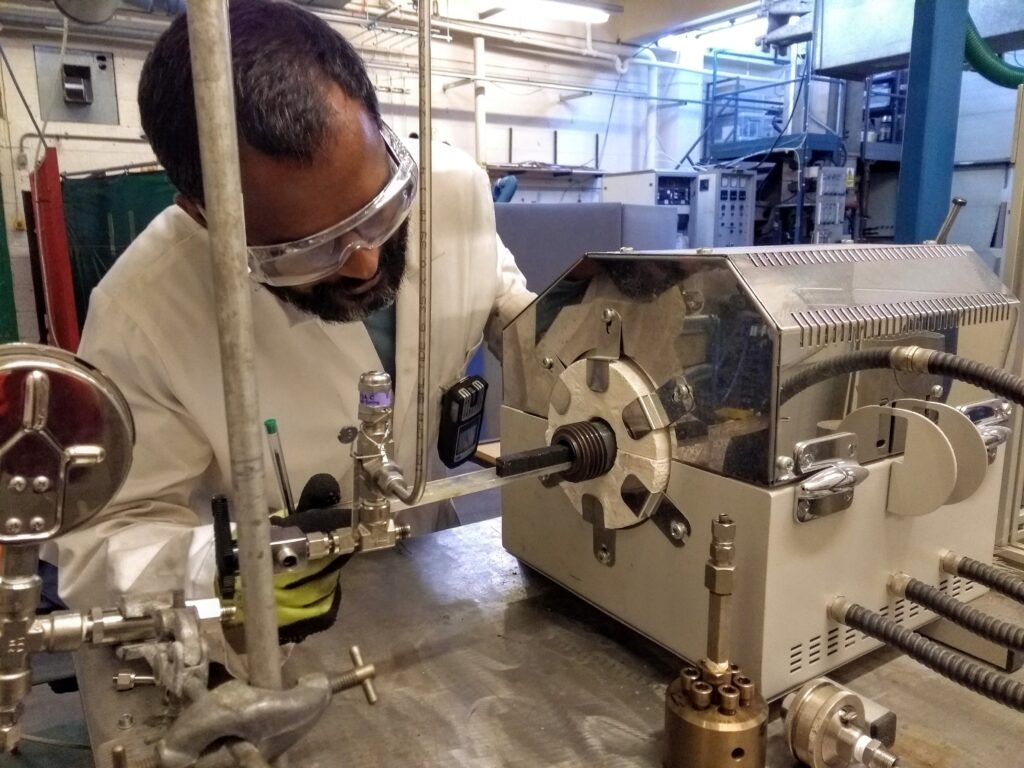Combining Geo-Energy Technologies for a Circular Carbon Lifecycle
A novel combination of techniques is offering the potential for low carbon energy and a carbon sequestration in coal rich regions which are home to heavy industry. FLEXIS researchers from Cardiff University’s Geoenvironmental Research Centre are laying the groundwork to understand the relationships between each of these intricate processes.
A Clean and Reliable Energy Independence
Coal is the most abundant source of energy in Earth’s crust, far beyond oil or natural gas. It powered the industrial revolution and for generations has been the backbone of Europe’s energy supply. But under pressure economically and environmentally, burning coal to produce energy is a diminishing practice. Just one example can be seen in the UK which recently set itself a new record by going over 2 months without burning coal to power the national electric grid.
Despite its prevalence in recent history, most coal is too deep or difficult to mine out of the ground. In fact, as little as 1/6th of the world’s coal is classified as an economically viable resource. The coal that is accessible is primarily useful for electricity, steel and cement production on a national scale but does not have the same versatility as other fuels. When burned in homes for domestic heating coal produces unwanted by-products and affects local air quality, restricting its use to vast industrial scenarios where emissions and pollutants can be captured and managed at scale under strict regulations. Facing these factors, the decline of coal as an energy source is a regular talking point against a backdrop of the climate crisis and the modern influx of cheap imported fossil fuels.
The side effect of this is that reliance on imported fuel creates both security and economic vulnerability. Governments are less able to protect their economies or mitigate the impact that global price fluctuations have on their citizens. Europe is particularly energy vulnerable compared with other areas of the world, importing just over half of its annual energy demand at a cost of more than a billion euros per day.
But, what if there was a way to utilise the rich, local coal deposits found throughout Europe without adding to the climate crisis? The trick may well lie in leaving the coal in the ground in the first place. MEGAPlus is a European funded project, coordinated by the Central Mining Institute of Poland, looking at highly innovative ways to utilise coal deposits that can result in a cost effective and low carbon energy source to help Europe maintain its energy security and independence.
Complimentary Techniques for a Low Carbon Future
As part of the project, FLEXIS researcher Dr Renato Zagorscak is working to introduce crucial improvements in understanding the innovative combination of high-pressure Underground Coal Gasification (UCG), Coal Bed Methane (CBM) and CO2 Capture and Storage (CCS) processes to produce high-quality synthetic natural gas (SNG). His work focusses on European coal seams that are too deep to mine using traditional methods, typically over 900 meters below the surface. Utilising such technologies in a responsible and safe way can significantly contribute to the sustainable prosperity of countries in need of affordable and reliable energy.
The idea, at a very broad level, is to drill a directional borehole down to the deep coal seam and then extract methane which can be fed directly into the gas network or converted into hydrogen. Using the same borehole, a combination of steam and oxygen can be used to gasify the coal seam and produce high-quality Synthesis Gas, or ‘syngas’. Syngas is a mix of high calorific value gases such as methane, hydrogen and carbon monoxide which can provide energy with fewer emissions and pollutants than digging up and burning coal in a traditional manner. SynGas also diversifies coal’s traditional uses by opening avenues to produce both domestic and transportation fuels and chemical feedstocks used in agriculture or even hydrocarbons for the fashion and pharmaceutical industries. The process of converting coal into the syngas leaves behind a void in the coal seam which enhances the potential of the nearby rocks and any overlaying coal seams to store CO2, forming the backbone of a carbon capture and storage (CCS) solution. It all comes together to create a circular lifecycle of safe, low carbon energy extraction, utilisation and then carbon capture and storage back into the original source.

The formal name for the process bares the impressive acronym CBM-UCG-SNG, which represents the combination of three complimentary areas of technology; Coal Bed Methane – Underground Coal Gasification – Synthetic Natural Gas respectively.
There are significant questions that arise from this innovative new approach; Just how much energy will be produced? How much CO2 can be stored back inside the coal seam? What is the resulting carbon-intensity of the energy? Are there environmental implications? And how much will this energy cost?
It is a complex and multidisciplinary challenge to untangle where many factors are dependent upon one another. For example, the team are developing numerical models and simulations that can accurately predict the 3D nonlinear reactor cavity growth within the coal seam during the UCG gasification and transport of by-products. The UCG reactor development not only impacts the syngas yield in the first part of the process, but also the amount of CO2 that can later be stored in the surrounding rocks. Other examples of the coupled nature of each process can be seen when looking at the overall environmental considerations. Cardiff University’s Geoenvironmental Research Centre developed an in-house numerical model called COMPASS to analyse coupled heat, moisture, gas pressure, deformation and stress behaviour in the geoenvironment. The researchers are particularly interested in applying COMPASS to provide a proper understanding of the types of risk to the environment and how the underlaying mechanisms interact. This is of paramount importance so that any risks related to the potential groundwater pollution triggered by the UCG process are properly assessed and managed.
To understand these relationships Dr. Zagorscak and his colleagues have been utilising the specialist equipment at the Geoenvironmental Research Centre. The bespoke High Pressure High Temperature (HPHT) Gasification Rig was used to recreate the conditions in a UCG reactor deep underground to assess how temperature, pressure and different levels of steam and oxygen impact the syngas yield. The experimental findings have been published in the prestigious “Fuel” international journal, a leading source of primary research work in fuel science. The team sourced 6 tons of Welsh coal for the purpose of the experiments, although the HTHP Rig focusses on experiments at a micro level of detail using approximately 50 grams of coal at a time. The Central Mining Institute of Poland are using the remainder of the Welsh Coal to prove Dr. Zagorscak’s findings at scale by reacting as much as 800kg per test. Through such collaboration, novel findings published in the “Energies” international journal demonstrate a high potential for Welsh coals to be utilised for syngas production.

FLEXIS Researcher Dr Sivachidambaram Sadasivam using the GRC’s High-Pressure High-Temperature Gasification Rig to find the most optimal experimental conditions for producing high-quality syngas from Welsh and Polish coals.
The data gathered from these experiments will be vital in creating a model of the entire circular process. It is with this model that the researchers can test the technical and economic feasibility of the combined approach.
Localising the Carbon Lifecycle
Tata Steel is working as part of the MEGAPlus consortium, representing one of the major users of coal in their coke production process undertaken at sites such as the Port Talbot Steel Works within the FLEXIS Demonstration Area. The results of the project will provide direct knowledge on how the utilisation of CBM-UCG-SNG can improve the decarbonisation and sustainability steel manufacturing. The complimentary technologies have particularly interesting application in regions where there are significant coal seams, energy utilisation and CO2 emissions all present at once. When these factors are located close together, the process has extra potential because there is far less consideration to be given to the transportation of energy and captured CO2 over long distances, which itself has a measurable carbon footprint and impacts financial feasibility.
Dr Zagorscak and his colleagues will work jointly with the project partners to provide best practice guidelines on the implementation of the proposed CBM-UCG-SNG technology to support new business developments for economic reactivation within Europe; and Communicate data with European Parliament and National Governments in order to assist divisions on participation in future European CBM and UCG programs.


